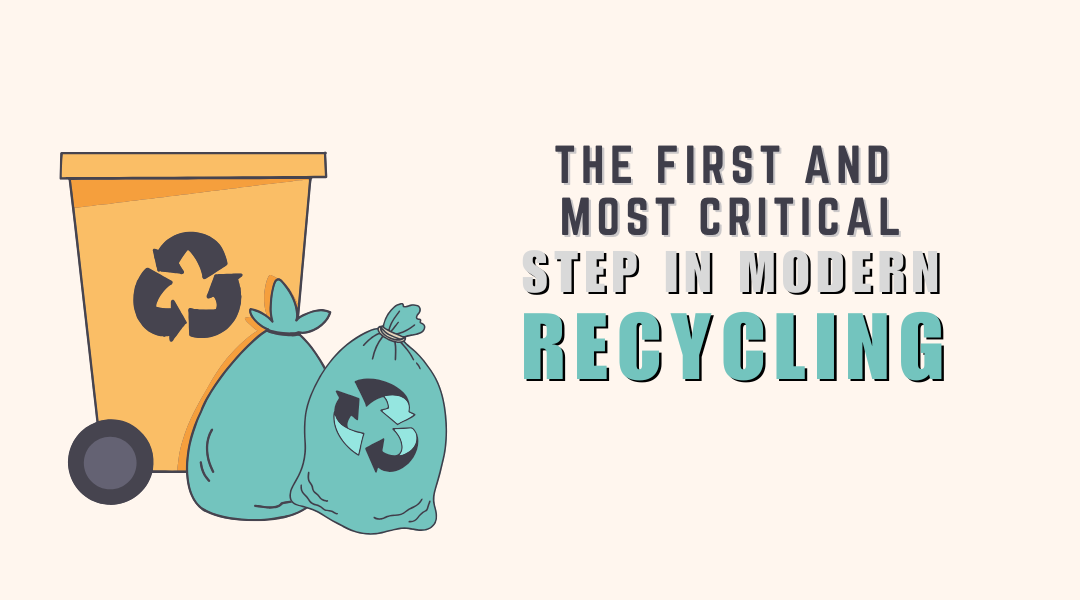Tossing everything into one bin is easy. It’s also the reason why so much of our “recycling” never actually gets recycled. The entire system, from your curb to the processing facility, hinges on one simple but powerful act: separation. Getting this first step right isn’t just a good habit; it’s the master key that unlocks the economic and environmental potential of the materials we used to call waste. This is a look at how to do it right, from your kitchen to the high-tech facilities that are revolutionizing the process.
The “Why”: More Than Just Good Intentions
When we mix our trash, we create a contaminated mess. A single food-smeared container can ruin an entire bale of otherwise clean paper, rendering it useless and destined for the landfill. Proper segregation prevents this.
- Purity Equals Value: Clean, well-sorted materials are a commodity. A bale of sorted, clear PET plastic bottles has a real market value for manufacturers looking to create new products. A mixed bag of dirty plastics is just garbage with a high handling cost.
- Supercharging Recycling Centers: When pre-sorted materials arrive at a facility, the process becomes faster, cheaper, and more efficient. Workers and machines don’t have to wade through hazardous or decomposing waste to find the valuable items, leading to a higher recovery rate and a safer work environment.
The “How”: A Practical Guide to Separation at the Source
The most effective sorting happens long before the garbage truck arrives. Here’s a practical, multi-layered approach you can implement at home or work.
1. The Four-Stream System: A Universal Framework
Instead of vague categories, think in terms of four distinct streams:
- The Recyclables Bin: This is for clean, dry, and empty items. Think aluminum cans, glass jars (lids removed), cardboard boxes (flattened), and certain plastics like bottles and jugs. Key Tip: When in doubt about a plastic item, check the local guidelines. If it’s not listed, it’s often better to put it in the general waste bin to avoid contaminating the whole batch.
- The Organics Bin: This is for anything that was once alive. Food scraps (vegetable peels, coffee grounds, eggshells), yard waste, and even certified compostable paper plates. Key Tip: Using a small countertop compost bin with a biodegradable liner makes kitchen collection effortless.
- The General Waste Bin: This is the bin of last resort—for anything that doesn’t fit in the other categories. This includes mixed-material packaging (like chip bags), styrofoam, and certain plastics. The goal is to make this bin the smallest one.
- The Hazardous & Special Items Pile: This isn’t a daily bin but a designated, safe holding area. This is for batteries, old electronics, paint cans, lightbulbs, and medications. These never go in the regular trash and must be taken to designated drop-off locations.
2. Beyond the Bins: Smart Habits for Cleaner Streams
The physical bins are just tools; the real magic is in the habits:
- The “Quick Rinse” Rule: Giving jars and cans a quick rinse prevents odors and avoids contaminating paper and cardboard in the recycling bin.
- Break Down Boxes: Flattening cardboard saves an immense amount of space in your bin and in the collection truck, making the entire system more efficient.
- Know Your Local Language: Recycling rules vary by city. Spend five minutes on your local waste management authority’s website. Knowing what your facility can and cannot process is more valuable than any generic guide.
The Tech Frontier: When Machines Take Over the Sort
For the materials that do get mixed, or to ensure purity, technology is stepping in with remarkable solutions.
- Optical Sorters: These systems use cameras and near-infrared (NIR) light to identify different material types. As items travel along a conveyor belt, a puff of air precisely blasts a specific material (e.g., all HDPE plastic) off the belt and into its designated collection chute.
- AI-Powered Robots: Artificial intelligence is now being used to train robotic arms. These robots, equipped with cameras and suction grippers, can learn to identify and pick specific items from a fast-moving waste stream with astonishing speed and accuracy, mimicking the human ability to recognize shapes and textures.
- Magnetic and Eddy Current Separators: These workhorses of Material Recovery Facilities (MRFs) use magnets to pull out ferrous metals (like tin cans) and eddy currents to repel non-ferrous metals (like aluminum cans), automatically segregating them from the rest of the stream.
Conclusion: The Ripple Effect of a Simple Act
Waste segregation is far from a mundane chore. It is the fundamental gesture of participation in a circular economy. That simple act of placing a rinsed bottle in one bin and a banana peel in another creates a ripple effect. It leads to cleaner raw materials for industry, reduced greenhouse gases from landfills, and the creation of green jobs. It transforms our relationship with stuff from a linear “take-make-waste” model to a circular one of “reduce, reuse, and regenerate.” By mastering the art of separation, we stop being just consumers and become active stewards of our resources, building a system where very little is truly wasted.
